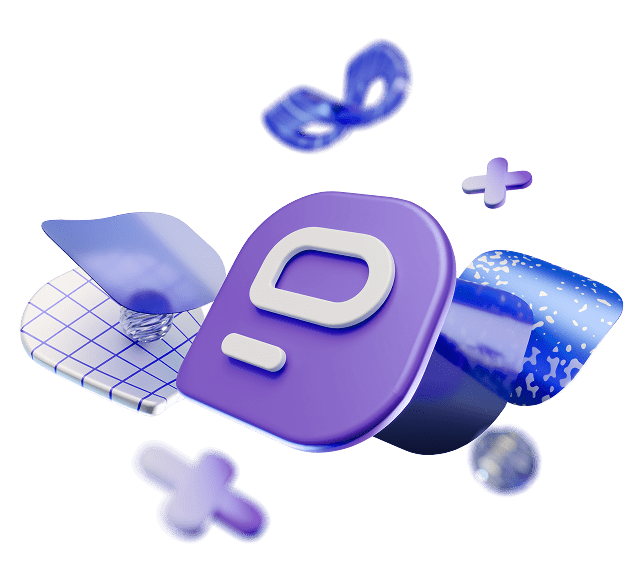Cross-functional teams seem to be the backbone of most successful companies since one of the benefits of collaboration is that it drives workplace performance.
But, if you’re just starting out in the corporate world, you might be wondering — what are cross-functional teams? And, more importantly, what are some cross-functional team examples that you can look up to to create the same type of cross-functional synergy in your workplace?
Today, we’re answering these questions as well as diving deep into the following topics:
- What are the benefits of cross-functional teams?
- What does effective cross-functional collaboration look like?
- What are the biggest benefits and challenges cross-functional teams face?
- How can we improve the ways these teams collaborate?
Let’s get into it!

- Cross-functional collaboration or XFN collaboration is collaboration between people from different teams or departments, who have a common goal.
- At the core of every cross-functional team are collaboration and communication. XFN teams foster teamwork and collaboration by transparently communicating, exchanging ideas, and sharing knowledge.
- Benefits of cross-functional collaboration are: enhanced engagement, defined roles, higher creativity and innovation, better alignment across departments, improved communication, and improved business agility.
- The top tips for improving collaboration in cross-functional teams are:
- Picking the right team members,
- Providing training,
- Assigning the right leader,
- Setting clear objectives and KPIs,
- Using boundary objects,
- Utilizing rewards and punishments,
- Recognizing the value of diversity,
- Building a common identity, and
- Utilizing collaborative technology.
What is cross-functional collaboration?
Cross-functional collaboration or XFN collaboration is collaboration between people from different teams or departments, who have a common goal.
This type of interdepartmental collaboration enables team members to use their diverse skills and specialized knowledge, which helps them solve problems and achieve better results through brainstorming.
What is a cross-functional team?
A cross-functional team is a group of people from different functional parts of an organization, who apply different skills, are highly interdependent, and work together to achieve a common objective.
These are groups consisting of a small number of people with complementary skills, who are mutually accountable and responsible for:
- Improving organizational performance,
- Re-imagining organizational processes,
- Developing new products, or
- Improving customer relationships.
At the core of every cross-functional team are collaboration and communication. Fostering teamwork and collaboration by transparently communicating, exchanging ideas, and sharing knowledge is what allows cross-functional teams to be:
- Efficient,
- Adaptable, and
- Innovative.
A good example of a cross-functional team would be a team where representatives of different departments — sales, marketing, product, engineering, and R&D — work together to improve their product and, in turn, customer experience.
Take a look at the image below to see what that cross-functional organizational structure looks like.

🎓 Pumble Pro Tip
Although cross-functional teams are vital for any organization, there are other team organizational frameworks that companies use. If you feel like learning more about various types of teams, you can take a look at our in-depth guide:
Benefits of cross-functional teams
Any type of collaborative work comes with its own set of pros and cons. Still, research shows that, due to the undeniable benefits of collaboration, collaborative work has increased in recent years.
But what are the specific advantages of cross-functional collaboration and what benefits can individuals see in working with cross-functional teams?
Let’s take a look.
Benefit #1: Enhanced engagement and motivation
Working on the same tasks repeatedly can kill even the strongest of enthusiasms. Switching this up from time to time — by working in a cross-functional team, for example — is the perfect recipe for higher engagement, as it makes people happier.
What’s more, collaborating makes people feel like a true part of a company. This is a particularly important engagement driver, as a Kincentric’s report on engagement claims that people who feel included are 8.4 times more engaged than those who don’t.
Furthermore, cross-functional team members are often encouraged to be autonomous when it comes to decision making and to take responsibility and ownership of their work.
That, in turn, makes them more engaged, since both autonomy and recognition are top drivers of engagement, according to Pumble’s 2023 Employee Engagement Statistics.
🎓 Pumble Pro Tip
If you want to see more engagement from your coworkers or employees, you’ll need to do more than just give them autonomy and recognition. To see how you can ensure optimal levels of engagement, check out this post:
Engage your employees over Pumble
Benefit #2: Defined roles and goals
A cross-functional team has members with diverse sets of skills as well as experiences — that’s what makes it so effective.
However, that also has a fringe benefit — the roles in the team are clearly defined. If you have Sally from Marketing working together with John from Sales to increase customer engagement, it’s pretty clear to both John and Sally who will be making cold calls and who will write the scripts for them.
Along with clearly defined roles come clearly defined responsibilities and, finally, goals. Of course, that doesn’t mean that every member of every cross-functional team immediately knows what their specific goal is. But they have a general idea.
🎓 Pumble Pro Tip
To find out more about team roles and the part they play when it comes to the success of any collaborative effort, read this guide:
Benefit #3: Higher creativity and innovation
Working within a diverse team can boost creativity and innovation in all team members. A systematic literature review titled Are Culturally Diverse Teams the More Creative Ones? shows that diverse teams are more creative and innovative.
Of course, diversity isn’t enough. Team members also need to be open-minded and there has to be organizational support from management in order for a team to truly thrive when it comes to creativity and innovation — something that cross-functional teams usually do have.
Benefit #4: Better alignment across departments
How well do you know what Jenny from HR in your company does all day? What about Jane from Sales? Do you know their daily tasks? Do you even know their job description?
Chances are, you don’t. Outside of their immediate teammates, people are rarely familiar with what individuals in other departments are doing.
Working in a cross-functional team changes that, as people from different departments work closely with those they have never even touched base with before. This, in turn, creates a better cross-functional alignment.
Benefit #5: Improved communication
A necessity in all cross-functional teams is effective communication.
Such teams have members who come from different backgrounds and have had different experiences, which is why they need to have amazing communication skills to communicate their point of view, opinions, solutions, and disagreements in a transparent and respectful manner.
This is a benefit of cross-functional collaboration that shouldn’t be overlooked — being in a cross-functional team makes people better, more effective communicators, which makes them more versatile team members.
🎓 Pumble Pro Tip
Since not everyone has the opportunity to work in a cross-functional team and improve their communication skills through that experience, here are the other ways you can ensure your teammates have top-notch communication skills:
Benefit #6: Improved business agility
Cross-functional teams don’t have the hindrance of waiting for inter-departmental communication to go through the entire cycle. So, because of their structure, they are able to move quickly.
Meanwhile, thanks to the versatility of skills and knowledge among team members, these teams can also come up with innovative solutions — something that’s beneficial for every business.
However, it’s important to note that not all organizations see benefits from employing cross-functional teams. In fact, in some cases, functional diversity may negatively impact performance.
Continuing on, the results a team accomplishes vary according to company size, its internal infrastructure, and the industry it belongs to. In addition, implementing effective company structures, practices, and procedures requires a lot of effort.
What are the characteristics of an effective cross-functional team?
How do we know whether the newly formed XFN partnership in a team will be effective?
To answer this question, we have to take a closer look at the features of high-performing cross-departmental teams. The more of these characteristics a team has, the more likely it is to be successful.
Characteristic #1: Permanence
As a general rule, permanent and long-term cross-functional teams have a better chance of success.
If a team is temporary, the organization may not see the value in improving the team members’ work setting or creating a positive work environment.
When a company knows that a team will be disbanded as soon as it finishes a project, it makes the company much less likely to assign significant resources to it.
So, when a cross-functional team becomes permanent, management cannot ignore their requests for better work conditions.
In the long run, the investments an organization makes to enhance work conditions and improve psychological safety for a cross-functional team will pay off through improved performance.
🎓 Pumble Pro Tip
Not investing enough resources into your cross-functional team may lead to poor performance. To find out other factors that can contribute to this, read the following guide:
Ensure top team performance — align your goals on Pumble
Characteristic #2: Clear, compelling, and challenging goals
Time and time again, studies have shown that cross-functional teams perform better when they have:
- Clearly set goals and
- Moderate challenges.
Without clear goals, people lack motivation. In contrast, with clear goals, they know what to strive for without falling into the trap of miscommunication in the workplace.
At the same time, it’s vital that project objectives aren’t too easy to achieve — as not enough stimulation leads to people getting bored — nor too difficult. Difficult or unachievable challenges might lead to employee disengagement — team members might distance themselves from the team objectives.
So, balance is key.
🎓 Pumble Pro Tip
Setting clear goals that strike the perfect balance between too easy and too difficult is a huge burden for many team leads and managers. To help you out, we wrote an entire guide on setting goals for your team:
Characteristic #3: Positive climate
High-performing cross-functional teams prioritize a positive work climate, placing value on the individual well-being of team members.
For example, some leaders — especially those employing a pacesetting leadership style — may decide that creating a sense of urgency emphasizes the importance of a project. However, that also creates tension, which leads to more conflict among team members.
In contrast, others — like a laissez-faire leader, for example — may be too lax about rules. That leads to employees not taking the project seriously, making it hard to get anything done.
A relaxed yet professional approach seems to work best for efficient cross-functional teams.
🎓 Pumble Pro Tip
Positive climate is just one of many key factors that contribute to great and effective team collaboration. To find out what the others are, read this guide:
Characteristic #4: Empowerment
Empowered team members, who are given a certain sense of autonomy when it comes to making decisions about a project, show more commitment to reaching the company objectives, research shows.
What’s more, they also have higher levels of job satisfaction, which can lead to up to 14% difference in employee productivity, according to Gallup.
Additionally, the speed of development increases with the level of freedom and responsibility team members have. Allowing teams to execute decisions reduces the time it takes to make decisions, solve problems, and take action.
So, collaboration grows when teams are allowed to make their own rules and procedures.
Characteristic #5: Exemplary leadership
Typically, leaders of productive cross-functional teams do not take direct action to help finish the project.
Instead, cross-functional leadership enables the development process — they provide boundaries, but also freedom and autonomy when it comes to decision-making.
Another way leaders enable collaboration is by implementing a participatory style of leadership, where team members are expected to share some of the leadership roles.
This shared leadership is vital for navigating the complexities of cross-functional teams, as it gives employees the freedom to explore, discuss, and challenge ideas about what technologies to pursue or which problems to solve.
Characteristic #6: Support from senior management
Support from senior management can be critical to the success of a team. In fact, it’s so critical that it justifies a strategic effort for senior managers to show more support for cross-functional teams by:
- Demonstrating commitment,
- Helping the team to surmount obstacles, and
- Providing encouragement.
Characteristic #7: Excellent communication
Arguably, the most important characteristic of successful cross-functional teams is effective communication.
We see many benefits from team members communicating with high levels of trust, honesty, and respect for each other, such as:
- Improved mutual understanding;
- Better collaboration;
- Increased productivity;
- Increased creativity;
- Increased adaptability to change;
- More effective problem solving;
- Improved employee morale;
- More successful conflict resolution;
- Improved trust;
- Certified future input.
So, good communication should be a priority within cross-functional teams. Even if all other technical requirements are fulfilled, the lack of proper communication can still bring the entire endeavor down.
What are the main challenges of cross-functional collaboration?
Ideally, a cross-functional team will tick all the boxes on the imaginary “characteristics” sheet. However, many teams don’t, which is why they find themselves facing specific challenges.
Let’s get into the specifics of each of those challenges and later see what cross-functional teams can do to overcome them.
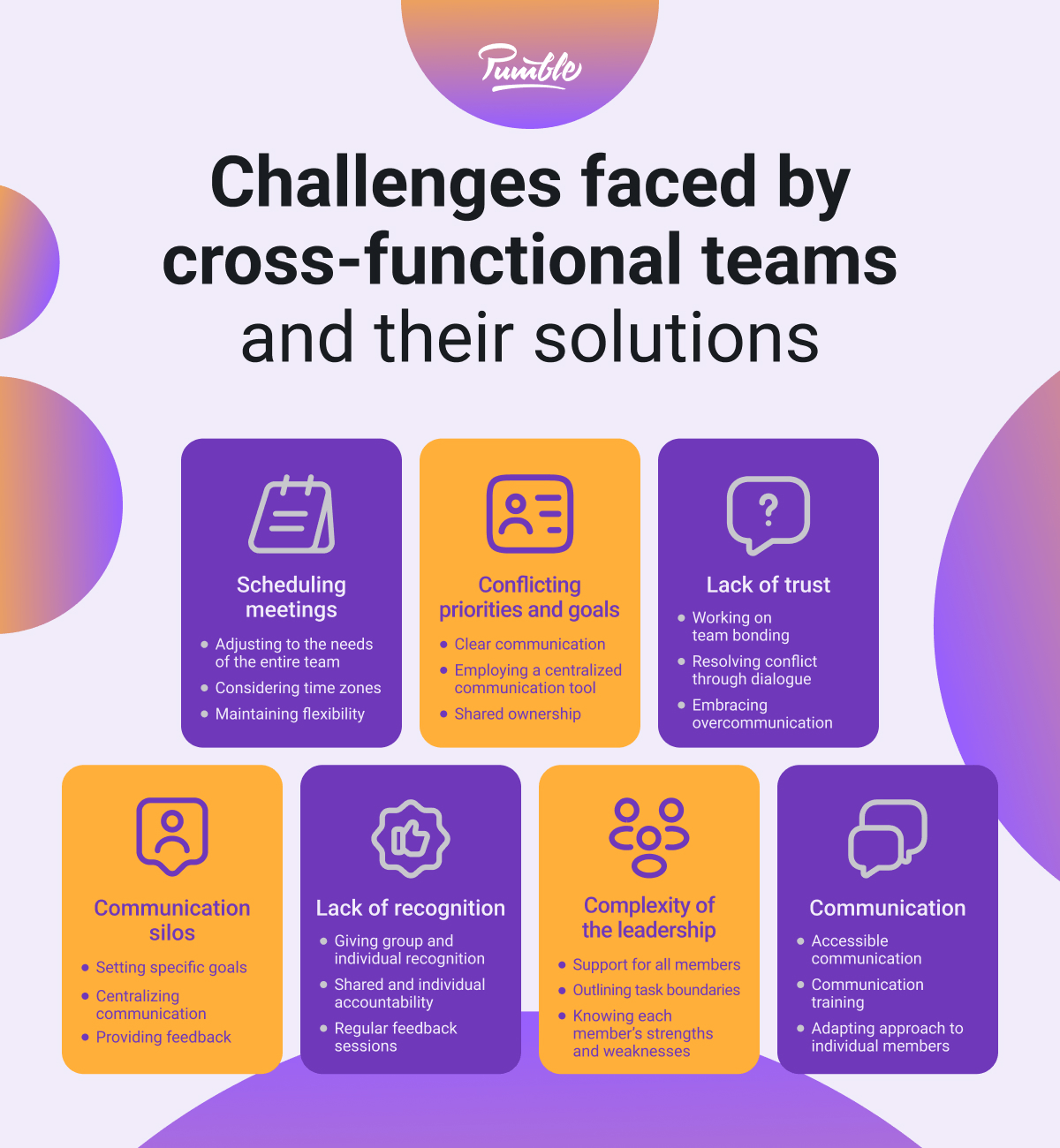
Challenge #1: Difficulty scheduling meetings
When we account for different types of work models, such as remote and hybrid work, scheduling meetings gets a little bit more complex.
Scheduling meetings for distributed teams with team members in different time zones can lead to misunderstanding, confusion, and frustrated people sitting alone in a video conference scheduled to start in an hour or two.
In addition, meeting times are usually adjusted to the needs of team leaders, due to their place in the workplace hierarchy.
Dealing with this challenge includes:
- Adjusting to the needs of the entire team,
- Always taking time zones into consideration, and
- Maintaining flexibility when it comes to scheduling.
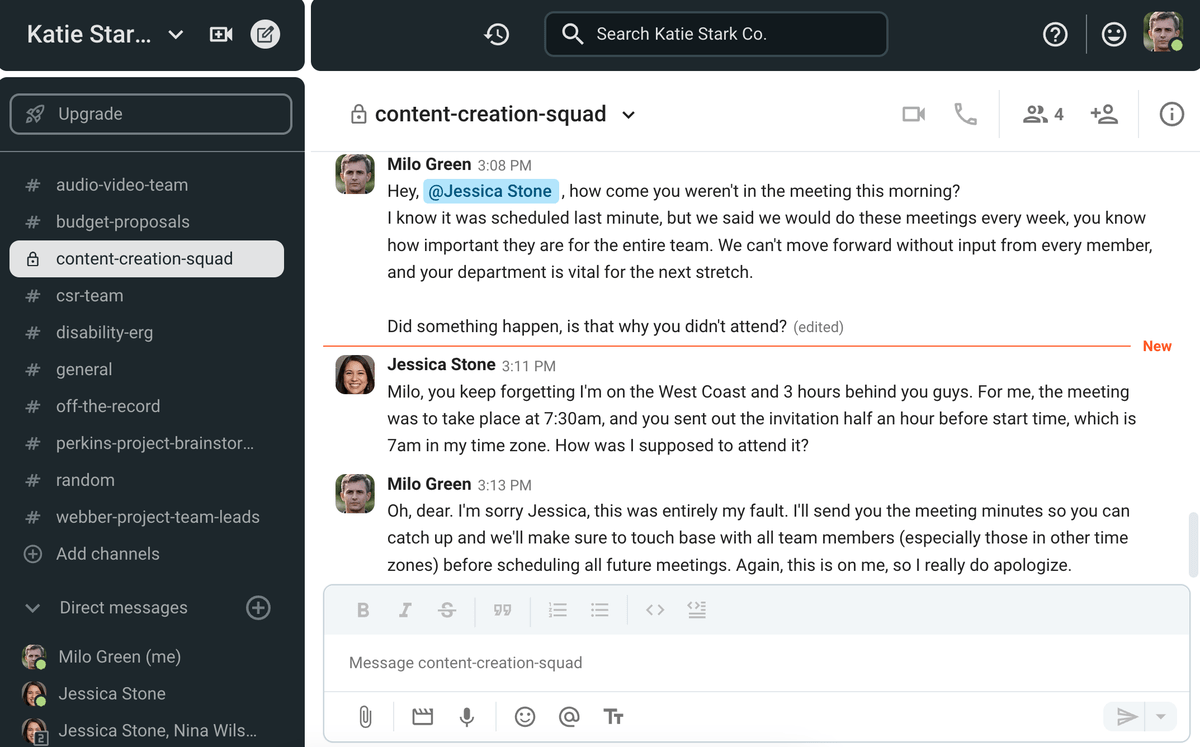
Schedule meetings easily over Pumble
🎓 Pumble Pro Tip
To find out how you can help your team work flawlessly across time zones, take a look at this post:
Challenge #2: Different priorities and goals
Next, we have situations where people have different functional priorities and objectives. The first issue can be attributed mostly to a lack of communication between different teams, as a result of not having a centralized communication system.
Likewise, a lack of communication combined with ambiguous goals makes for misinterpreted objectives. Due to the limited duration of the project team, employees rarely have the time to resolve their different ways of thinking, so their efforts often become incoherent.
Overcoming this particular challenge isn’t easy, but it can be done via:
- Clear communication — Transparent communication can help team members stay connected.
- A centralized communication tool — A communication tool like Pumble that streamlines communication allows all members to quickly and easily communicate and adjust their goals and expectations.
- Shared ownership — When team members feel equally accountable for project objectives, they’ll be more inclined to have aligned goals.
Communicate and set goals over Pumble
Challenge #3: Lack of trust
The lack of trust in cross-functional teams comes from putting people with no previous acquaintances in a high-pressure environment.
This results in great discomfort for the team members who do not feel secure enough to freely communicate with each other. As a result, teams try to escape the discomfort by lowering standards to finish the project early, effectively escaping the situation.
Building trust in teams takes time, but you can start by:
- Working on team bonding — Creating opportunities for the team members to get to know each other and create a bond will go a long way.
- Resolving conflict through dialogue — Letting conflicts simmer by not addressing them is never a good idea.
- Embracing overcommunication — Teams with a lot of members from different departments can’t afford a lack of communication, which is why they should learn to overcommunicate.
🎓 Pumble Pro Tip
Building trust in a team isn’t easy, especially when the team is functioning fully remotely. To get the best tips on how to build trust in your team, check out this post:
Challenge #4: Communication silos
Due to their nature — being made up of people from different functional units — cross-functional teams run an increased risk of developing intra-team silos.
For example, engineers might find it hard to work with designers, as they have distinctly different approaches to work.
So, in a cross-functional team, they may resort to keeping to themselves, creating the infamous silos. This was true even before the COVID-19 pandemic but is especially pertinent now with many companies taking the remote-first approach, which limits opportunities for collaboration.
To ensure all team members are collaborating without creating silos, you should:
- Set specific goals that require everyone’s effort,
- Use a centralized collaboration tool to avoid grapevine communication, and
- Provide feedback and encourage others to give feedback to their peers.
🎓 Pumble Pro Tip
To find out more about strategies you can use to deal with silos, check out this article:
Challenge #5: Lack of recognition
When employees feel like they lack adequate rewards and recognition for their efforts, they have no incentive to perform to the best of their ability.
Therefore, when team collaboration is encouraged but not appropriately rewarded, employees may feel like it is too much effort with little in return.
Dealing with the issues that arise from lack of recognition is somewhat simple — always ensure you provide both individual and group recognition and encourage people to be accountable for their work.
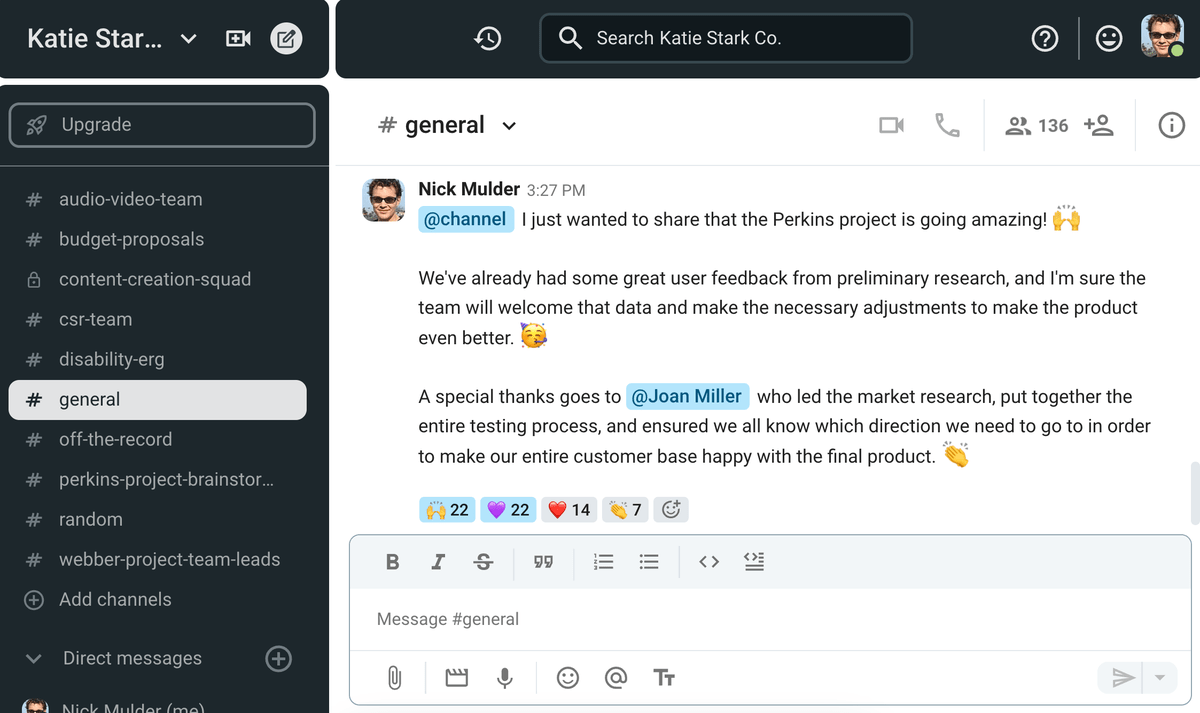
Show recognition and give praise over Pumble
Challenge #6: Complexity of the leader’s role
Due to the complexity of the team leader’s role, it is probably best to employ someone with proven skills in leading multidisciplinary teams who can support all team members because they can easily distinguish their strengths and weaknesses.
A leader with little previous experience may find it difficult to juggle the needs of employees from different functional areas. Also, they may have a hard time outlining tasks and combining the efforts of all team members into a productive system.
🎓 Pumble Pro Tip
If you’re just starting out in the managerial field and are worried about not doing right by your team, check out this post:
Challenge #7: Lack of (effective) communication
There are numerous barriers to effective communication, stemming from reasons such as physical limitations, emotional and cultural barriers, differences in personality, etc.
In cross-functional teams, these lead to misunderstandings, frustration, and tension in the workplace.
But, most importantly, poor or negative communication hinders accomplishing the goals the team was created to achieve in the first place. This means that the quality of communication between team members can make or break the entire project.
Some research on team structure in cross-functional teams shows that there’s a correlation between communication and group size.
Namely, small cross-functional teams should increase communication to facilitate creative problem solving, while big teams should try not to overcommunicate so as not to overload the team members.
However, either way, team communication needs to be effective.
🎓 Pumble Pro Tip
Ensuring proper communication in cross-functional teams requires a lot of planning. To see how best to plan out the internal communication of your team, read this article:
Improving XFN teams — 10 best tips and examples
Overcoming the challenges cross-functional teams face isn’t simple. However, we came up with the best 10 tips and concrete examples of how you can ensure your cross-functional initiatives don’t fail.
Let’s take a look.
Tip #1: Select the right team members
Selecting the right team members is the first critical step to establishing successful cross-divisional collaboration.
We asked Michele Olivier, Principal Consultant and Founder of O&H Consulting, for some advice on how to select these kinds of employees and where you can go wrong. In her opinion, a cross-functional team needs people who can work well with others, rather than representatives of all departments.

“First off, what many employers do right now is to have representatives from all the different areas meet with the candidate and assess how they would work with them. This results in a lot of interviews, and not very much unique information. What’s needed is a candidate who can seamlessly work cross-functionally and engage with stakeholders — internal and external. Having every department weigh in doesn’t really establish that.”
She continues to break down the term “cross-functional collaboration” into several more easily measured components:

- “An ability to communicate complex ideas simply and in a language understood by all,
- Questioning skills with a willingness to ask enough questions to really understand the needs and process of an unfamiliar area,
- Being able to motivate/coach people not within your line of report, and
- A willingness to admit their mistakes and change course.”
The other precondition for successful collaboration you should take care of is that all necessary functional areas of the company are represented in correct proportions. This means that you should find a balance between too many people doing the same thing and stepping on each other’s toes and on the other hand, people burning out trying to achieve unrealistic goals.
Example of selecting the right team members
Kayla, a hiring manager, has the choice between hiring two designers with equally impressive resumes. Where she makes the decision is when comparing interview questions aimed at assessing how open-minded they are. One candidate expressed a defiant attitude when asked about admitting mistakes, so Kayla chooses the other, more agreeable candidate.
Tip #2: Provide appropriate training
All teams can benefit from providing appropriate training for their members. You should try to provide all necessary resources needed to demonstrate methods and tools team members can use during their work.
By this, we mean both the technical side of things and the instructions on how to handle interpersonal conflict and communication. This way, you prepare employees for the challenges they can expect to face.
Example of providing appropriate training
Angela is a newly hired agent in customer support at a SaaS company. During her first week, she undergoes thorough training on how to use the technologies her company uses internally. This includes instructions on how to use project management software, online workspaces, and time tracking software.
Next, she is introduced to the product the company hosts. And finally, Angela goes through meetups with HR, to get familiar with how to handle conflict, and who to come to if she needs help. She is now fit to independently deal with her responsibilities.

Onboard and train employees over Pumble
Tip #3: Assign an experienced leader
A person with experience in multidisciplinary teams will be more effective for cross-functional collaboration than a leader who’s only ever led traditional teams.
These people will find it easier to be proactive in ever-changing situations. They are ready to take an objective look at all the advantages and disadvantages of the development process, and to take steps to improve it.
In short, experienced leaders have a more farsighted view of the production process, and are able to find solutions that fulfill company expectations.
Example of assigning an experienced leader
Austin was the initial team leader of a team in charge of product design. Unfortunately, he had issues with coordinating team members, leading to not finishing an important project on time and losing a long-term client.
With this in mind, the company assigns Jason as the new team leader. Jason has plenty of proven experience in leading teams responsible for new product development. He also switched careers at some point, which gives him the ability to view issues from different perspectives and be much more organized and productive.
Tip #4: Set clear organizational objectives
Establishing clear organizational goals provides a common frame of reference for the team. Having set objectives helps structure tasks and creates boundaries to their accomplishment.
When it comes to boundaries, we specifically mean:
- Defined deadlines for project completion,
- A set appraisal schedule, and
- A meeting schedule.
You can do this by employing the principles of strategic leadership and shifting priority from tactics to strategy, and from output to outcome.
This lets the employees feel more involved and creates a better environment for collaboration.
Example of setting clear organizational objectives
A new start-up has only one objective:
“Develop a competitive product in our niche with as few resources as possible.”
All other internal processes and structures are organized around this principle. So, the employees always know to emphasize affordable solutions and eliminate all unnecessary expenses.
In addition, they are guided to focus on products and services with proven market value, so innovativeness is somewhat limited. This practice extends to the hiring process, as they look for fewer, but more experienced employees.
Communicate objectives and goals over Pumble
Tip #5: Create key performance indicators
An effective way of tracking performance is creating key performance indicators (KPIs). KPIs are strategic goals expressed in measurable values. They are an objective means of measuring collaboration.
Some of the KPIs focus on measuring financial performance — for example, Net Profit or the Revenue Growth Rate.
Others pay attention to client feedback, by measuring the Customer Satisfaction Score or tracking the Net Promoter Score.
Example of using KPIs to measure cross-functional collaboration
Susan is a team leader for a cross-functional team put together to improve customer satisfaction. To measure the success the team has in reaching their goal, Susan decides to use the following KPIs:
- Customer Satisfaction Score,
- Client Retention Rate, and
- Net Promoter Score.
As for the effectiveness of the team, she decides to implement the Employee Engagement Index, Employee Satisfaction Score, as well as Revenue Growth rate to see how things progress on the financial side of things.
🎓 Pumble Pro Tip
To get a more detailed insight into measuring collaboration with KPIs, visit our guide:
Tip #6: Use boundary objects
To combat the difference between team members’ deep knowledge, you can use so-called boundary objects or tangible definitions. These objects are pragmatic representations used to inform multiple communities.
Boundary objects can be:
- Concrete boundary objects or artifacts — stable and recognizable objects, used as containers of meaning to facilitate collaboration.
- Epistemic boundary objects or epistemic objects — fluid, incomplete, and constantly evolving to meet the needs of explaining the difference between knowledge among team members.
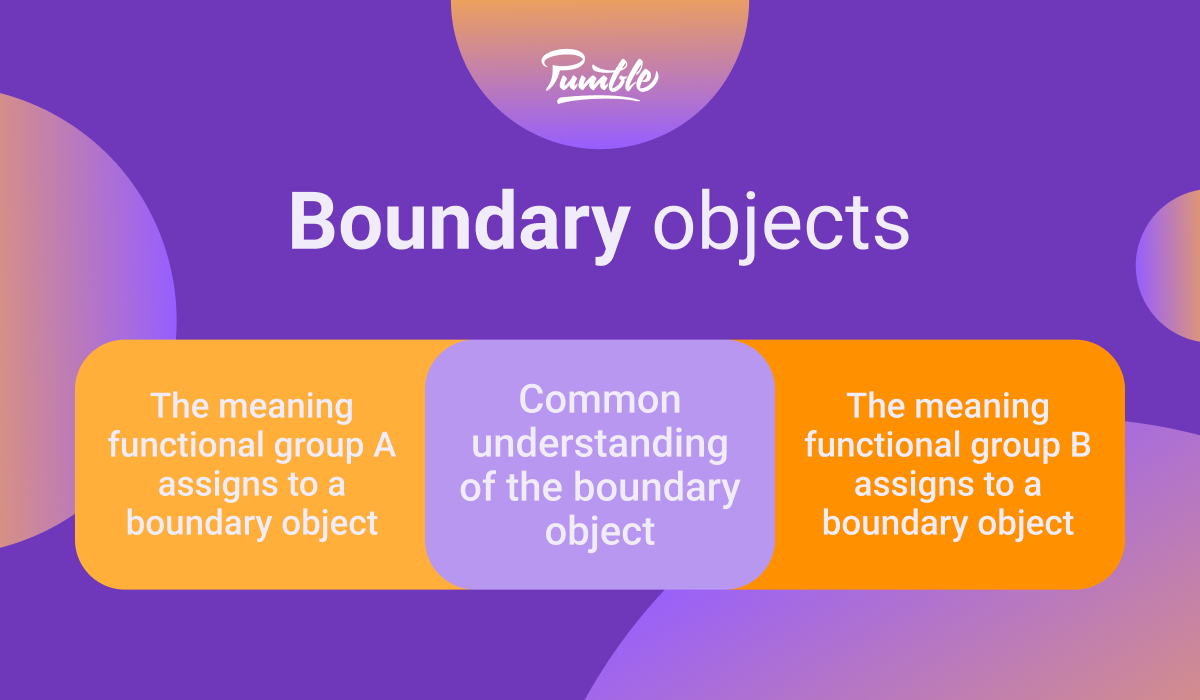
Example of using boundary objects
Jake is a team leader in charge of getting a factory line up and running. He decides to use a boundary object to delineate to all team members what the expectations are.
To do this, Jake believes the most efficient boundary object is a machine prototype that demonstrates the mechanisms at work. This prototype serves to bridge the gap between engineers and machine operators, establishing more successful collaboration.
Tip #7: Be transparent about rewards and repercussions
Both rewards and repercussions are efficient ways of motivating employees. However, they work in different ways.
With a reward in mind, people will push themselves to perform better. Likewise, when “punishments” are overtly discussed, it gives employees an incentive to stay on the right path. This rule is simple but commonly overlooked.
Example of reward and repercussion transparency
Kaytlin is an accountant, and she knows that if she misses another deadline to turn in her assignment, she will lose her opportunity for promotion until the next appraisal period. So, she works extra hard and tries to organize her time as efficiently as possible.
Foster transparent communication with Pumble
Tip #8: Recognize the value of diversity at work
Here we have two different kinds of diversity in mind — one is the diversity of people and the other is functional diversity.
When it comes to the diversity of people, it is important to take a stance about discriminating against people according to their race, gender, and sexuality. You should make sure that the workplace is welcoming to all kinds of people.
The other kind of diversity is the functional diversity of cross-functional groups. When many functional units are represented in a team, there is an increase in the variety of available information.
Therefore, team members are provided with the chance to view the project from multiple perspectives.
Example of hiring a diverse team
Craig is a Talent Acquisition manager who decided to try an experimental approach to hiring a diverse team. To prevent bias, he publishes a job opening but requests that candidates exclude any information (including name and pictures) that can reveal their age, gender, race, or sexuality. He then asks the candidates who fit the requirements to complete a task.
Once he selects the people with the skills to successfully finish the assignment, the pool of candidates is significantly smaller. Only then does Craig invite the candidates to in-person meetings and video conferences. As a result, he is sure his personal bias had minimal effect on the person he selects for the job.
🎓 Pumble Pro Tip
To help you get your teams as diverse as possible, we prepared a guide that will lend a helping hand. Check it out:
Tip #9: Build a common identity
Fostering a common identity — the “we” in a team — has many benefits. First of all, the sense of unity gives people motivation to put in extra effort to accomplish team goals.
To best accomplish this, implement a special team structure that delegates decision-making authority to the team. Collective rewards also increase the sense of community. A team building event, for example, is also an activity that increases the sense of common identity.
Example of building a common identity
Carrie is a member of HR in a software development company. She decides that a good activity to build a common identity is participating in a tree-planting activity. For her, this is the ideal solution, as it is both good for the environment and allows the employees to spend a day in nature, getting to know each other better.
Tip #10: Ensure your technology stack enables collaboration
Teams collaborate better when they have a clear idea of what everyone is actually doing. The easiest way to make this happen is by using quality team collaboration technology like Pumble.
Also, the technology you use is better when centralized, allowing both messaging, video conferencing, and file-sharing capabilities.
Example of using technology to enable collaboration
In the following example, we have Steve, Fiona, and Harry scheduling a visit to stores, in search of inspiration for a new cooking line. Their team communication app allows them all to voice their opinions, as well as react with emojis to what they read.
If they feel the need to contact other team members, they can always check their online status, and add them to the group conversation.

Easily communicate with your entire team on Pumble
Additional tips: Assessing potential candidates for XFN teams
As our expert, Michele Olivier, mentioned, there are 4 skills every member of a cross-functional team has to have:
- An ability to communicate complex ideas in simple language,
- Questioning skills,
- Being able to motivate and coach people not within line of report, and
- The willingness to admit mistakes and change course.
So, to ensure we have the right people for our cross-functional team, we have to assess each of these.
Skill #1: Communicating complex ideas in simple language
To assess this ability and ensure a candidate has the skill to explain something so everyone understands them, Michele advises:

“Have a non-technical team member (HR, CS, recruiter, etc) ask a technical question relevant to the role. Explain to the candidate that they are not technical, and that they will need a simplified version. Then have that person rate the candidate on:
1. Clarity of explanation,
2. Checking for understanding throughout,
3. Lack of use of industry jargon,
4. Ability to answer follow-up questions.”
Skill #2: Questioning skills
Next, we should assess the level of willingness a candidate has to ask enough questions to really understand the needs and process of an unfamiliar area.
Michele believes that questioning skills can easily be assessed with some more typical interview questions.

“These include giving the candidates a scenario to engage with, and asking how they would approach it. When doing this, you should intentionally limit the amount of information given and let them know they can ask anything that they need. Then, look out for questions about the basic premise, such as what are we trying to achieve or who is the stakeholder.”
Skill #3: Motivating and coaching people outside their line of report
According to Olivier, assessing this particular ability is quite easy with the right questions, such as these:

1. “Tell me about a time you had to motivate someone, not within your direct line of report, to achieve a professional goal.“
2. “How do you bring people onsite who are resistant?“
3. “Give me an example of a time you had to provide difficult feedback to someone.“
Skill #4: Willingness to admit mistakes and change course
When it comes to assessing the willingness to admit mistakes and change course, according to Olivier, some of the best questions to ask may be:

1. “Tell me about the last time you were wrong at work.“
2. “When was the last time you changed a process or approach?”
3. “What inspired the change?”
4. “How did you know if the change was successful?“
The hiring process is the perfect time to evaluate the collaboration potential of a candidate. If you do this properly, you run a much lower risk of the candidate being ill-fitted for the existing team. As a result, establishing effective collaboration is more straightforward.
Perfect your cross-functional collaboration with Pumble
Cross-functional collaboration doesn’t come easy, but, with a lot of effort and the right tools, you can ensure your cross-functional environment runs smoothly and effortlessly.
We know communication is the primary necessity for cross-functional teams. With Pumble — a team communication and collaboration app — communication is centralized, transparent, and accessible.
Pumble can help you keep track of what your cross-functional team is doing thanks to:
- Dedicated groups,
- Direct messaging,
- Audio calls, and
- Video conferencing.
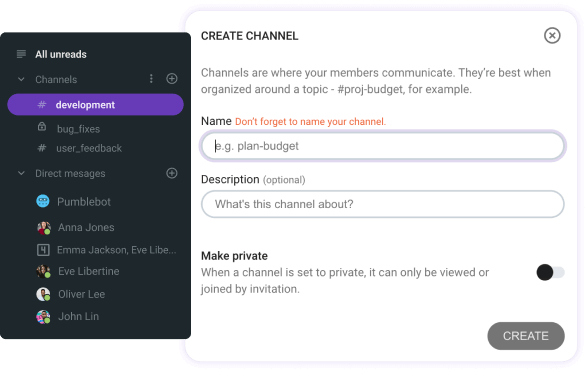
With Pumble, knowledge and file sharing is easier than ever, since you can send documents of any size from any device. What’s more, you can keep track of all of them effortlessly, thanks to the sort and filter features.

Highly customizable, easy to use, and familiar to everyone — Pumble is the perfect pick for cross-functional teams. So, don’t hesitate — improve your team collaboration and communication and achieve those company objectives!
How we reviewed this post: Our writers & editors monitor the posts and update them when new information becomes available, to keep them fresh and relevant.





